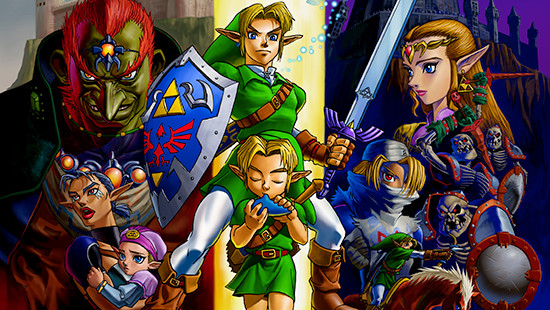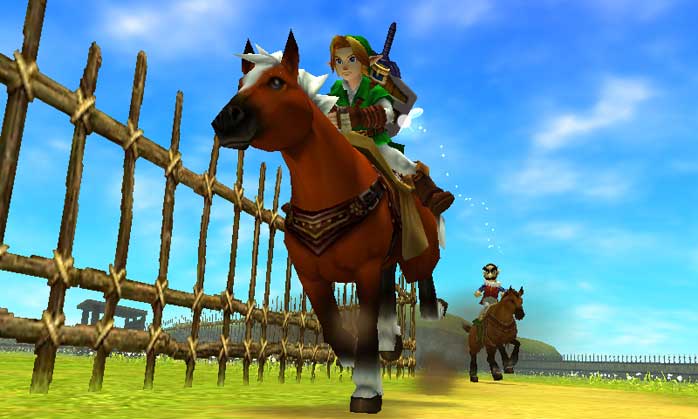Zelda 35th anniversary: Why Ocarina of Time is still my favorite
Hey listen! Ocarina of Time is my favorite Zelda game

The Legend of Zelda: Ocarina of Time is one of the best games I’ve never finished. My tenuous excuse is that I used to get stuck a lot, and it takes a while to figure out the dungeons. As a kid brought up in the internet-less wilds of rural West Wales, with sports and school taking up my time, my progress through Ocarina of Time was glacial.
As I made my way through this N64 game in a piecemeal fashion, PC and original Xbox gaming arrived to court my attention. Then I moved out of my childhood home, leaving my N64 behind, with Link waiting to take on the boss at the Spirit Temple. I was so near the end, and yet so far. Until the relative freedom of university life, I’d always played games in fits and spurts. Yet despite my bizarre approach to it, Ocarina of Time is seared into my memory.
And rightly so. At the time, Ocarina was a staggering game. Even today, it still offers an experience that feels different than so many modern games that have taken inspiration from it.
I remember, likely with a heady dose of nostalgia, getting out of the Kokiri Forest and into Hyrule Field. That green space with pure blue skies and multiple routes to explore seemed vast to my young mind — a mind untouched by the open worlds of The Witcher 3 and Skyrim.
The sheer volume of things to gawk at, explore, slice, and snag with the hookshot felt incredible at the time. And arguably, they still feel incredible.
I remember zipping onto the roofs of the houses Kakariko Village, more than a decade before blinking onto Dunwall townhouse roofs in Dishonored.
Ocarina of Time is stuffed to the Zora gills with memorable moments. From getting your horse, Epona, to the zombie horror that Hyrule Castle Town becomes after you draw the Master Sword from the Temple of Time, to the impossibly catchy theme tune of Gerudo Valley.
Sign up to get the BEST of Tom's Guide direct to your inbox.
Get instant access to breaking news, the hottest reviews, great deals and helpful tips.
But more than that, Ocarina of Time felt like a properly advanced game. Not only did you have to apply a whole load of items to solve dungeon puzzles, but you could also use various tools, or even songs tapped out on the titular Ocarina of Time, to dispatch enemies. A shot from the hookshot could stun a particularly mobile enemy, letting you slice it up.

The tone of Ocarina of Time was also fantastically varied, but in a fashion that made sense rather than feeling disjointed. The refreshing brightness of Hyrule Field in daytime tuned into a menacing expanse at night, with skeletal enemies rising out of the ground at every turn.
Hyrule Castle Town is a cluster of cheer and color as young Link. But for adult Link, it's a ghost town filled with ReDead zombies that still give this 34-year-old writer the shivers. (And I've just remembered the Wallmaster. That's even scarier.)
A bevy of exciting and smart boss battles, as well as a suite of challenges, such as the one to get Biggoron's Sword, sprinkle yet more magic on Ocarina of Time.
While the Legend of Zelda games have a rich history and heritage for newer titles to draw upon — looking at you Breath of the Wild 2 — I’d argue that Ocarina of Time is one of the most influential Zelda games. There’s a clear throughline from Ocarina to Breath of the Wild, which is another easy contender for the best game of all time.
Thanks to Eon Gaming’s Super 64 unit, I'm now able to run my N64 on my 4K TV. And as we’re now celebrating 35 years of Zelda, I think it’s about time I had another stab at Ocarina of Time. Now, I may finally finish it.
- More: Where to buy Nintendo Switch online — these stores have stock
Roland Moore-Colyer a Managing Editor at Tom’s Guide with a focus on news, features and opinion articles. He often writes about gaming, phones, laptops and other bits of hardware; he’s also got an interest in cars. When not at his desk Roland can be found wandering around London, often with a look of curiosity on his face.

